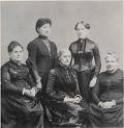Josephine Sophia White Griffing 1814 - 1872
November 24, 2007
 Josephine S
Griffing 1814
Josephine S
Griffing 1814
- 1872
For two decades, abolitionists and suffragists had worked alongside one another after the Civil War in America, and as a result Griffing was close comrades with homeopaths and homeopathic supporters, as homeopathy was seen as central to the new wave of reform sweeping the country. They all supported one another.
Susan B Anthony, Elizabeth Cady Stanton, Lucretia Mott, Martha Coffin Wright, Ernestine Rose, Frances Gage, Antionette Brown Blackwell, Amelia Bloomer, Susan Edson, Caroline Brown Winslow, Caroline Severance, Lucy Stone, Stephen Foster, Frederick Douglass, Samuel J May, Parker Pillsbury, Theodore Tilton and very many others - the list runs into the hundreds.
Griffing also knew homeopathic advocate Belva Lockwood, the first woman candidate for the Presidency of America, homeopath Mary Edwards Walker and homeopath Julia Holmes Smith, and together, they formed the Universal Franchise Association and campaigned for Women’s Suffrage, where many others came to offer support.
Elizabeth Cady Stanton remembers those days:
In 1869 I gave my name, for the first time, to the New York Bureau, and on November 14 began the long, weary pilgrimages, from Maine to Texas, that lasted twelve years; speaking steadily for eight months from October to June every season.
That was the heyday of the lecturing period, when a long list of bright men and women were constantly on the wing. Anna Dickinson, Olive Logan, Kate Field,—later, Mrs. Livermore and Mrs. Howe, Louisa May Alcott, Phillips, Douglass, Theodore Tilton, George William Curtis, Beecher, and, several years later, General Kilpatrick, with Henry Vincent, Bradlaugh, and Matthew Arnold from England; these and many others were stars of the lecture platform.
In order to further Woman’s Suffrage, Griffing joined with homeopaths and others to form the National Woman Suffrage Association which began when homeopaths Elizabeth Cady Stanton, Caroline Brown Winslow, Susan Ann Edson, Clemence Lozier and homeopathic supporters Lucretia Mott, Susan B Anthony, Lucy Stone, Julia Ward Howe, Carrie Chapman Catt, Frances Willard, Matilda Joslyn Gage, Anna Howard Shaw, Martha Coffin Pelham Wright, Mary Wright Sewell, Josephine S Griffing and others decided it was time to become politically active.
An early, active abolitionist, Griffing’s home served as a way station on the underground railroad. Like many other abolitionists, she was an early supporter of women’s rights: she was elected president of the Ohio Woman’s Rights Association in
- Yet, from 1851 to 1855, she was a paid agent of the Western Anti-Slavery Society.
During the Civil War, she founded the Freedman’s Bureau (an organization to help the emancipated slave make a successful transition to freedom by supplying food, clothing, shelter, education, job training, etc.) during the Civil War.
After the organization was operating smoothly, it was incorporated into the War Department where services got tangled in bureaucratic red-tape. She was elected first vice-president of the new American Equal Rights Association (1866), was a founder and president of the Universal Franchise Association of the District of Columbia (1867), and was chosen to be corresponding secretary of the National Woman Suffrage Association (1869).
Griffing was a tireless campaigner against slavery, defending Sojourner Truth and very many others after the Civil War. The Freedman’s Bureau upon which Congress first tried to build the reconstruction measures was the idea of Mrs. Josephine Griffing.